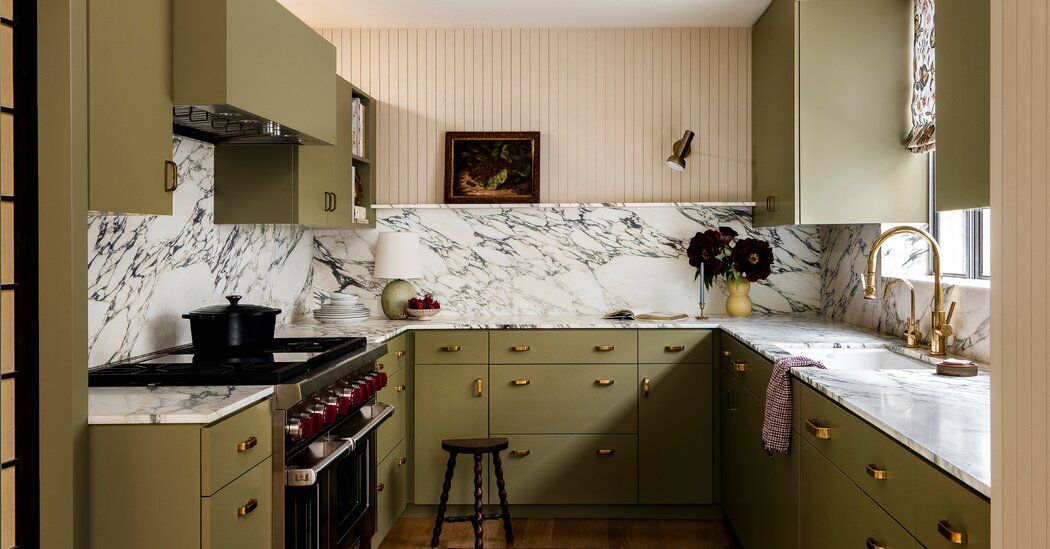When you’re renovating a kitchen, it’s easy to get carried away with the choice of cabinets, countertops, and appliances. But there is another element that also matters: lighting.
“The importance of lighting in a kitchen is two-fold,” said Rush Jenkins, CEO of WRJ Design in Jackson, Wyoming. “One is to have enough light on the surfaces to see what you are doing. The other is decorative lighting, which can enhance a home in the same way that precious jewelry enhances a beautiful outfit.”
And now that food preparation spaces also serve as gathering places, using lighting to set the mood is more important than ever, said Jenn Feldman, a Los Angeles-based interior designer.
“The kitchen is not just a place you go to cook,” Ms. Feldman said. “It’s a living space.”
She and other designers shared tips on how to light the kitchen.
Create layers of light
Professional architects and designers rarely use a single fixture to illuminate a kitchen. Instead, they focus on creating layers of light with different types of fixtures used in different ways.
“I love cooking and baking, and when I work I need it shiny,” said Blair Moore, founder of Moore House Design, in Warren, Rhode Island. But if you invite friends over for cocktails and canapés, you want something more. .
“When I’m entertaining, I want to make sure there aren’t any lights on,” he said. “That’s when we use ambient or accent lighting.”
The best way to achieve it? Using appliqués or similar accessories.
Ms. Moore added, “I always like to have three layers of lighting”: general lighting, task lighting, and ambient or accent lighting. This makes it easy to light the room in different ways.
Start with the most basic lighting
When making a lighting plan, you should start by choosing fixtures for general lighting: surface-mounted ceiling fixtures, linear track systems, or recessed can lights.
Regardless of the type of accessory you choose, location is key.
“People want these spaces to be well-lit, but we really try to think about what we’re lighting,” said Matt Berman, founding principal of the New York-based architecture firm Workshop/APD. That means focusing on countertops, circulation paths, and key functional areas like the sink and stove.
His company typically lines up ceiling lights along cabinets, Berman said, rather than installing a grid of recessed fixtures that cover the room with light.
All of the designers interviewed for this story like ceiling fixtures that are so discreet they almost disappear. When using recessed fixtures, they prefer smaller opening ceiling lights, with a two- or three-inch opening, and trim-free designs that install flush with the ceiling with a coat of drywall compound. Mr. Berman also likes recessed track systems that hold multiple lights within a single cutout in the ceiling.
Add more light on work surfaces
Even with most of the room lit, it’s helpful to bring focused lighting to the counters where you’ll be cutting vegetables, carving meat, and grating cheese. If you don’t have upper cabinets, one way to do this is to install simple sconces or pendants that shine light onto the countertops.
Ms. Feldman added brass sconces to her own kitchen countertops. Ms Moore has used articulated scissor arm sconces that can extend and rotate to provide light where needed.
If you have upper cabinets, a better solution is often to add LED strips under the counter. Hidden with a valance or recessed into cabinets, they can illuminate the entire length of a counter while remaining hidden from view.
“It’s so helpful to have under-cabinet lighting,” said Meghan Eisenberg, a Los Angeles interior designer who chose a stylish sconce to illuminate her own kitchen countertops, but now wishes she’d added under-cabinet lighting as well.
“We didn’t do it and I lived to regret it,” he said. “Because it’s really nice to have under-cabinet lighting when you’re cleaning and the upper cabinets cast shadows.”
If you are concerned that the inside of some cabinets is too dark, you can also add LED strips inside the cabinets that will automatically turn on when doors and drawers are opened.
Make a statement with decorative accessories
Don’t miss the opportunity to make a statement in the kitchen with decorative accessories, just as you would in a dining room. Often this is a chandelier or a series of hanging lamps over an island.
Jenkins of WRJ Design has used brass and bubbled glass chandeliers from Lindsey Adelman, leather and frosted glass pendants from Allied Maker, and linear smoked blown glass fixtures from Gabriel Scott to dramatic effect.
“You have a wonderful interior,” he said, “and then when you introduce beautiful lighting, it enhances it and creates a focal point.”
But it is important to consider what else there is around that meeting, he added. If the dramatic fixture interrupts the sight lines of a view window, Jenkins will look for a fixture with clear glass diffusers. Otherwise, he could opt for an accessory with opaque or translucent shades that match other materials used in kitchen cabinets and furniture.
It’s also wise to study nearby light fixtures, if the kitchen is open to other living spaces, Eisenberg said. When your kitchen island is next to a dining table, you’ll hang a single statement accessory over just one of those areas.
“I always choose where I want people to focus,” he said. “I don’t want to have one pendant hanging over the dining room table and then another in the kitchen.”
Plan controls
To make the most of so many layers of lighting, you’ll need to be able to control them. At a minimum, the different types of lighting (general, operational and decorative) should be divided into separate switches. Using dimmers is even better.
The next step would be a home automation system with smart dimmers, which will allow you to configure scenes for different times of day and uses. “That way you can create a night scene where the lights are dimmer and a morning scene where the lights are nice and bright,” Berman said.
It’s also important to know the color temperature of the different lights you plan to use. While LEDs with a color temperature of 2,700 Kelvin are similar to incandescent bulbs, Berman said, in the kitchen, “we’ll bump it up to 3,000 Kelvin, which is a little brighter and whiter.”
That color temperature is great when you’re making breakfast, but it may not be ideal if you want a warmer, softer light for cocktail hour. One solution is to look for fixtures that use dim-to-warm LEDs, Berman said, gradually switching to warmer color temperatures as they dim.
Whether you use dim-to-warm lights or not, all of your kitchen fixtures should have a similar color temperature.
“There’s nothing more annoying than having a beautiful warm light” in one area, Jenkins said, “and then a bright white, fluorescent-like light next to it.”
Embrace Plugin Options
While most kitchen lighting is integrated, you can add some extra lumens to dark corners and an extra touch of style with plug-in lamps. Eisenberg, Feldman and Moore have all used table lamps in kitchens.
“I’ve always liked having a table lamp on the counter,” Moore said. Especially now that kitchens serve as living spaces, he added, “I love that they look like furniture.”
Ms. Feldman likes the look so much that she designed a kitchen with a switch outlet above a wall shelf, so she can plug in a table lamp and connect it to the same wall dimmer as the sconces.
“Lamps are a really fun and beautiful way to play dress up the space,” Ms. Feldman said.
In the end, lighting a kitchen “is really about the sum of all the parts,” he added. “Which is no different than how you cook in a multi-ingredient kitchen.”
To receive weekly email updates on residential real estate news, sign up here.












